|
|
Family ICHNEUMONIDAE - Ichneumon Wasps
Members in this family have long and thin body, with narrow waist like wasps. Adults are active in day time and feed on flowers. Some species are colourful. Adults are minute to very large in size.
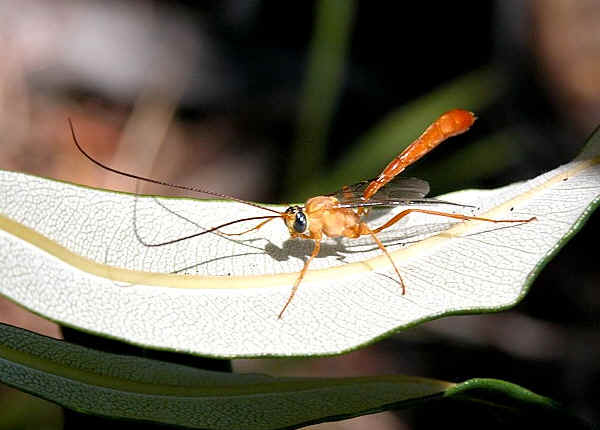
- Body length 20mm
Their larvae are either parasitic or hyperparasitic (living parasitically upon a parasite). Most caterpillars and pupas are targeted host. Some species attacked other insects and spiders. The female wasp usually locates the food plants of the host then searches with her antennae for a suitable host. The female usually has the long ovipositor which is used to insert eggs into the host body. Some species the ovipositor is longer than the female's body. The length of the ovipositor allows the female to inject her eggs into hidden hosts such as leaf-rolling or stem-boring caterpillars
Some species lay eggs externally and attack the host from outside. The host will usually survive when the larvae is still living. Until the larvae fully grown, the larvae either pupates inside the dead host or form a cocoon outside.
- Orange Pupa Parasite Wasp

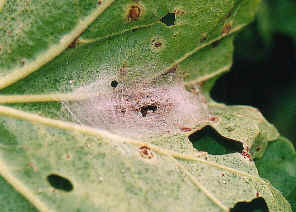
- Lissopimpla sp., subfamily Pimplinae, body length 15mm
- We found this Ichneumon Wasp laying eggs into a moth pupa. Click on here for the whole story.
- Yellow-banded Ichneumon Wasp

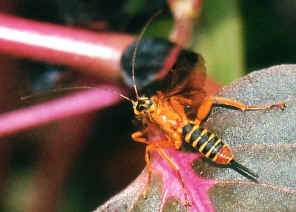
- Xanthopimpla sp., subfamily Pimplinae, male and female, body length 22mm
- This is quite a large Ichneumon wasp. We found the male and female flying on vegetations in someone's front yard during a sunny day in mid winter. They both have the typical wasp colour pattern and with very long antenna. Notice the female have the long and strong ovipositor at the tip of her abdomen. More information please also visit this page.
- Orange Caterpillar Parasite Wasp
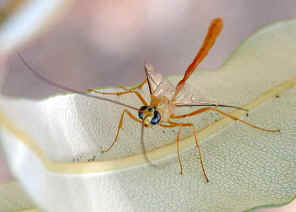
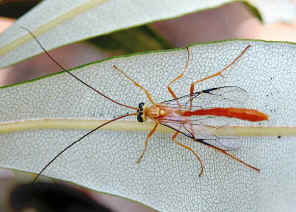
- Netelia producta, subfamily Tryphoninae ,body length 20mm
- Pictures taken when the wasp resting on a Banksia tree leaf in Alexandra Hill during late summer. The wasp is Reddish orange in colour, female will give a painful sting. Their hosts are those large size caterpillars. More information and pictures can be found in this page.
- Black and White-striped Ichneumon Wasp


- Gotra sp., subfamily Phygadeuontinae, female and male, body length 15mm
- We often find them in our backyard, land on the leaves and search for prey to parasite. They target at large cocoons of moths. They lay eggs in the prey body where their larvae live and grow inside. We usually find a pair of female and male searching on the same plant. The about pictures show a female with long ovipositor and a male without it. Click on here for more information and pictures.
- Banded caterpillar parasite Wasp

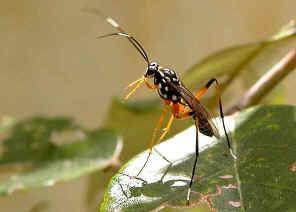
- Ichneumon promissorius, subfamily Ichneumoninae, female, male body length 15mm
- We took this picture in in early summer. The wasps have white band on the antenna, with large white dots on black body. Their legs are orange-brown in colours. They are pupal parasitoids of moth caterpillars. More information and pictures can be found in this page.
- Two-toned Caterpillar Parasite Wasp
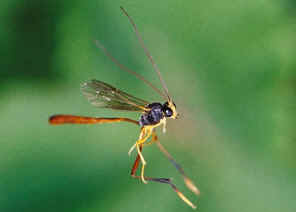
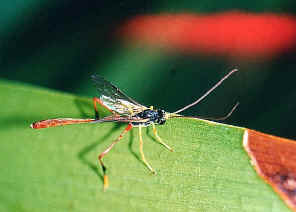
- Heteropelma scaposum, subfamily Anomalonine, body length 20mm
- This wasp was get caught by a spider web (first picture). Some other wasps of the same species were wandering near by (second picture). We believe they were searching for caterpillars to parasite. This wasp is common in Brisbane garden. They are often found flying around low bushes about one meter above ground. More information and pictures can be find here.
- Hover Fly Larvae Parasite Wasp

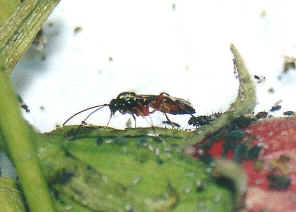
- Diplazon laetatorius, subfamily Diplazontinae, body length 10mm
- The Hover Fly Larvae Parasite Wasp is in family ICHNEUMONIDAE and also called Ichneumon Wasp. The wasp is shiny black in colour with brown legs and brown abdomen. There is the white segment on their hind legs. This species is endoparasites of Hover Fly larvae. More pictures and information can be found in this page.
- Case Moth Larvae Parasite Wasp


- ? Metopius sp. subfamily Metopiinae, body length 20mm
- In early spring we found this Ichneumon Wasp attacking a case moth caterpillar on a Acacia tree. Although the caterpillar was protected by its case bag, it seemed it was useless to prevent the attack from the wasp. We saw the caterpillar head come out a few times try to get rid of the wasp but no use either. The wasp kept on punching her long ovipositor into the case bag for over halve an hour. Please also visit this page.
- Reference and Link:
- 1. Insects of Australia, CSIRO, Division of Entomology, Melbourne University Press, 2nd Edition 1991, pp 943.
- 2. An introduction to the Ichneumonidae of Australia - Gauld, I.D. 1984, British Museum.
- 3. Parasitoids: Natural enemies of helicoverpa - Department of Primary Industries and Fisheries, Queensland, 2005
